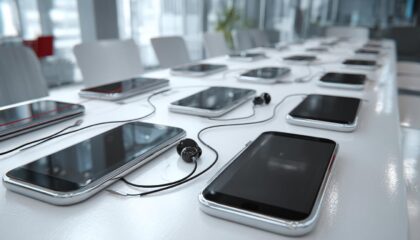Rental solutions for companies
Disadvantages of iPhones in corporate use – why rental instead of buying can make sense
Disadvantages of the iPhone: Is it really worth buying for companies?
In the world of smartphones, the iPhone is synonymous with quality, design and prestige. Apple has built up a loyal fan base with the iPhone – including many companies and business customers. However, although the device has many advantages, there are also some clear disadvantages, especially in a professional environment. In this article, we highlight the relevant disadvantages of the iPhone from the perspective of companies looking to rent or procure Apple iPhones and analyze in which situations other options might make more sense.
1. Price-performance: High costs with low flexibility
The most obvious disadvantage of an iPhone is the high purchase price. Even for older versions, business customers often pay above-average prices. In combination with relatively expensive accessories and limited third-party compatibility, this results in a relatively poor price-performance ratio compared to other devices.
| Model | iPhone 15 Pro | Samsung Galaxy S23 | Google Pixel 8 |
|---|---|---|---|
| Purchase price (average) | 1.199 € | 999 € | 799 € |
| USB-C port | Yes (Pro only) | Yes | Yes |
| Custom ROMs / customization | No | Yes | Yes |
For companies that want to customize their IT infrastructure, the iPhone is often too restrictive and expensive.
2. Closed system hinders individualization
The Apple ecosystem follows the “walled garden” principle. For business users, this means that customizing and special applications are difficult to integrate into the devices. The App Store is highly curated and the installation of third-party software without approval is hardly possible (except via Apple Business Manager and VPP programs, which cause additional admin work).
- No support for alternative app stores
- No direct file management possible like on Android
- Only very limited multitasking – even on the iPhone 15 Pro
- Compatibility problems with company-specific software
Especially in B2B rental, where devices need to be configured for special events, trade fairs or software demos, flexibility is a must – this is where the iPhone often reaches its limits. Alternatives such as Samsung Galaxy Foldables offer significantly freer configuration options and a variety of innovative usage scenarios.
3. Restrictions on accessories and connectivity
For years, the Lightning connector was a trademark of iPhones. It was only with models such as the iPhone 15 Pro Max that USB-C was introduced – and at full speed on the Pro models. For companies that already rely on a standardized charging infrastructure, this means additional effort. Apple is also lagging behind the market when it comes to other interfaces:
- Limited support for external monitors (only via AirPlay or adapter)
- No native support for mouse or trackpad (unlike iPads)
- Bluetooth connections often only stable with Apple-certified devices
While Samsung DeX or Windows offer emulated desktop environments via cell phones, this is simply not possible with iPhones.
4. Lack of compatibility with MDM and remote management
Mobile Device Management (MDM) is a core component in corporate networks. Although Apple offers certain options via the Business Manager, device management is more complex compared to Android devices. This is especially true for small to medium-sized companies:
- Higher administrative effort for device enrollment
- Limited remote maintenance options
- Paid tools for the full use of MDM functionalities
Especially in the B2B rental business, this is a significant argument against the standard procurement of iPhones.
6. Repairs: Expensive, complicated, slow
The iPhone repair process is notoriously expensive and restrictive. Original parts are expensive and third-party providers are hardly allowed to install spare parts without Apple certification. Even simple repairs such as replacing batteries or displays can be expensive.
These factors play a role here:
- Hardly any support for self-repair programs in Europe
- Low modularity design – makes quick repairs difficult
- Slow or cost-intensive official repair processes
This is particularly critical for B2B rental: the downtime makes on-site deployment significantly more expensive.
7 Data protection – both a curse and a blessing
Apple is positioning itself strongly as a data protection champion. While this is fundamentally positive, companies can suffer as a result. For example, when using external analytics and tracking software or location data for fleet solutions. Many of these options are severely restricted or are only possible with user interaction.
Apple also restricts the integration of external security solutions, VPNs or firewalls at system level.
Conclusion: iPhones are status symbols – but not always the best choice in B2B
The iPhone remains unchallenged in terms of prestige, usability and design. However, for companies and especially in the B2B rental of mobile devices, it is important to keep an eye on the disadvantages. The key is not to choose the “best” device across the board, but the right device for the respective purpose.
Interested in technical diversity and individual solutions for your company or event? We will be happy to advise you on suitable smartphones – whether classic Apple devices, ultra-modern Samsung foldables or other alternatives.
Read more - You may also be interested in
Would you like to delve deeper into the topic or discover similar content? Below, we have compiled three additional articles for you that are thematically related to this article. These may also be relevant and interesting for your company.










